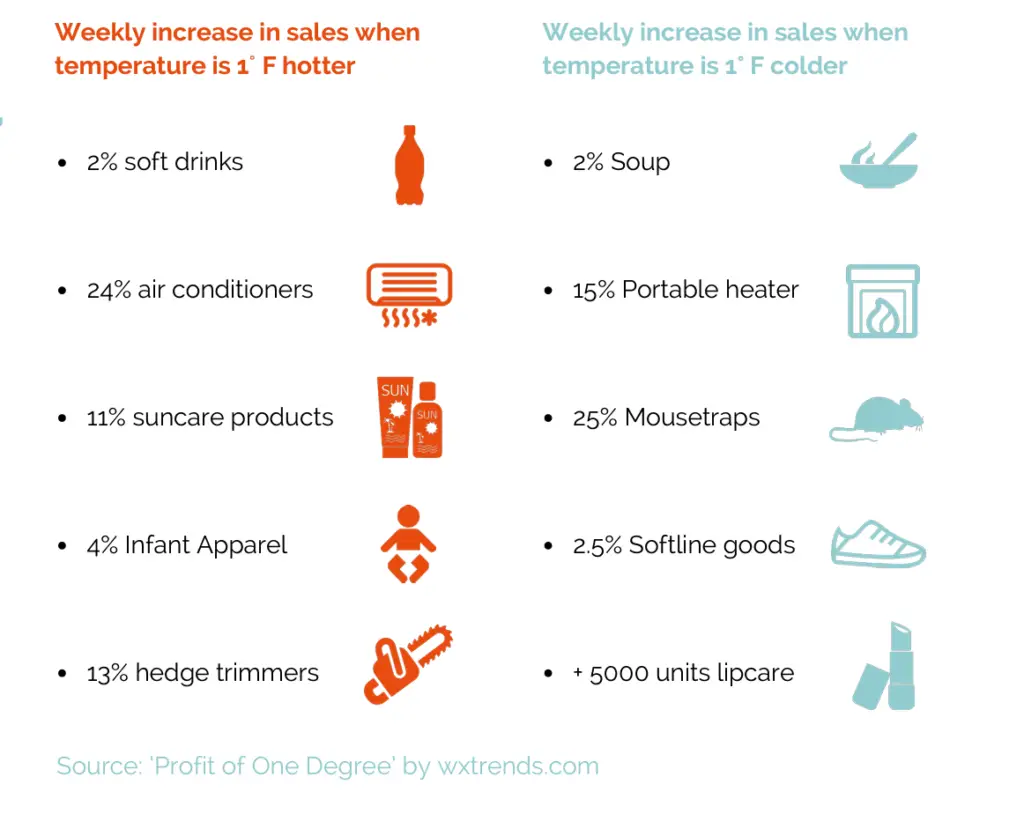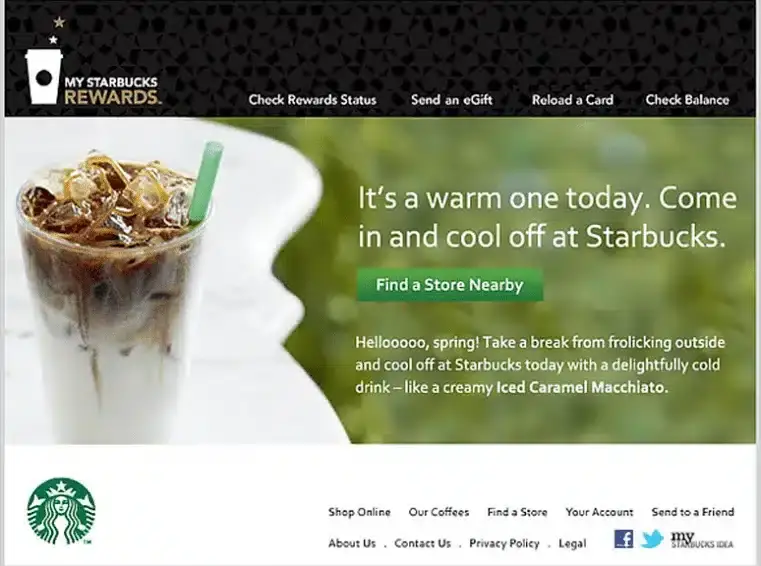In marketing, mass communication through owned channels like websites, blogs, and social media remains the standard, ensuring broad reach and a consistent content flow. However, today’s consumers increasingly demand personalization, expecting tailored interactions and content. Brands must blend wide-reaching strategies with customized experiences to meet these evolving preferences effectively. In what has quickly become an over-saturated marketplace, the key to successful marketing is delivering relevant content to the right audience at the right time.
Leveraging dynamic capabilities is the most effective way to do this. This principle holds especially true for businesses in the Fast-Moving Consumer Goods (FMCG) sector, where seasonal trends based on weather changes and Google trends heavily influence consumer purchasing behavior.
According to Getambee.com, “Weather-based marketing can drive sales by 150 to 300% in best-case scenarios and 30 to 68 % on average.“ Consider the change from Winter to Spring; as soon as that first warm day hits, everyone suddenly needs lawnmowers, barbeques, garden furniture, and pool chemicals. You will lose potential customers if those products aren’t immediately front and center.
By harnessing dynamic capabilities, such as real-time data integration and audience segmentation, digital catalog platforms can adapt swiftly to changing seasons, ensuring market relevance and driving sales. According to Thrive Marketing, “Weather is the second biggest influence on consumer behavior after the economy. It also plays a substantial role in the U.S. private sector, contributing to an estimated $3 trillion in business activities.”

Saving time with dynamic capabilities in digital catalogs
Dynamic capabilities refer to a platform’s ability to integrate, build, and reconfigure internal and external competencies to address rapidly changing environments. In digital catalog platforms, dynamic capabilities involve the agility to update product listings, content, and promotions in response to shifts in market demands, customer preferences, and external factors like weather patterns.
Specifically, pulling in many of your products dynamically into online catalogs allows you to save hours on manual work and set up rules to automate product placements based on availability, seasonality, popularity, etc. For example, you can set a rule to say that if a particular product is being purchased 30% more than usual due to good weather, it will be pulled onto the first page, or if a product is out of stock, it will be replaced by many variations you can specify.
The ability to adapt digital catalogs to seasonal trends has manifold benefits. First, it enhances market relevance by aligning product offerings with consumer preferences and needs.
Customers who encounter products tailored to their demand are more likely to engage and purchase. Secondly, it optimizes marketing efforts by capitalizing on the heightened interest and demand surrounding specific seasonal themes or occasions. By leveraging dynamic capabilities to curate seasonal content, businesses can effectively capture the attention of their target audience and drive conversions.

Credit: Thrive Marketing Agency
Six key benefits of dynamic capabilities when doing weather-based marketing
- Real-time data integration:
Digital catalog platforms can integrate real-time weather data into their systems. APIs like OpenWeatherMap or WeatherStack provide accurate and up-to-date information about local weather conditions. By utilizing this data, platforms can dynamically adjust their product catalogs to reflect the current weather, ensuring relevance to the users.
Outside of weather-related APIs, the Publitas platform, for example, can also sync with Google Trends and dynamically change and update products based on what people are searching for most.
- Smart product recommendations:
Dynamic capabilities enable digital catalog platforms to offer personalized product recommendations based on weather forecasts. For instance, users might be more inclined towards refreshing beverages, lightweight clothing, or outdoor accessories on a hot summer day. Platforms can suggest relevant products by analyzing weather patterns and user preferences, enhancing user engagement and satisfaction.
- Seasonal product rotations:
Weather seasons influence consumer preferences and purchasing behaviors. Digital catalog platforms can leverage dynamic capabilities to rotate their product offerings seasonally. For example, they can transition from winter coats to spring dresses as temperatures rise. By proactively updating catalogs, platforms can align with evolving market trends and capitalize on seasonal demand.
- Contextual content marketing:
Dynamic capabilities empower digital catalog platforms to craft contextual content marketing strategies based on weather conditions. Leveraging weather-related themes in promotional campaigns, social media posts, or email newsletters can resonate with users and drive engagement. For instance, an outdoor gear retailer runs ads for hiking boots on weather apps, targeting users in areas where a sunny weekend forecast is predicted, encouraging them to gear up for outdoor adventures.
Another example of contextual marketing is showing ads to users for long-term savings accounts for college to new parents looking at baby products.
- Adaptive pricing strategies:
Weather fluctuations can impact product demand and supply chain dynamics. Digital catalog platforms can employ dynamic pricing strategies to optimize sales and inventory management. For instance, they can offer discounts on winter apparel towards the end of the season to clear inventory or implement surge pricing during peak summer months for high-demand items like air conditioners or sunscreen.
- Enhanced user experience:
Digital catalog platforms can enhance the user experience by incorporating weather-aware features into their interfaces. Displaying weather forecasts, recommending relevant products based on current conditions, or providing location-specific recommendations create a personalized and intuitive shopping journey. Such enhancements foster customer satisfaction and loyalty.
What is the process of implementing dynamic capabilities?
Dynamic capabilities ensure market relevance by enabling digital catalog platforms to adapt swiftly to changing seasons.
Using customer data for audience segmentation
Dynamic capabilities also enable audience segmentation based on customer data, allowing personalized marketing strategies tailored to individual preferences. Here’s how it works:
- Audience segmentation via DMP / CDP: The platform leverages Data Management Platforms (DMPs) or Customer Data Platforms (CDPs) to segment their audience based on demographics, behavior, and preferences.
- Set product business rules based on data: Within the Publitas platform, you can set business rules based on customer data, ensuring that the right products are showcased to the right audience at the right time. For example, customers who have previously purchased gardening tools may be targeted with promotions for seasonal gardening supplies.
Dynamic and creating 1-on-1 personalization
Personalization is key to engaging customers and driving conversions. Dynamic capabilities facilitate 1-on-1 personalization by leveraging customer data and purchase history. Here’s how personalization is achieved:
- 1-on-1 customer segmentation via DMP / CDP: Platforms can deliver personalized product recommendations and promotions tailored to individual preferences by segmenting customers into smaller, more targeted groups.
- Track historical purchases & user interests: Platforms can track customers’ historical purchases and user interests to gain insights into their preferences and behavior.
- Show products based on purchase history: By analyzing purchase history, platforms can showcase products likely to resonate with each customer, increasing the likelihood of conversion.
Here’s how we do it at Publitas:
- Product feed and content scraping: The platform can source product data from various suppliers through product feeds or by scraping content from online sources. This ensures the catalog is continuously updated with the latest products relevant to the current season.
- Create standardized templates: To streamline the process, create standardized templates for themed releases. These templates can include placeholders for product images, descriptions, and pricing, making populating the catalog with seasonal offerings easy.
- Guide design with weather & trend insights: By integrating weather data and trend insights, the platform can guide the design of seasonal catalogs. For example, during the summer season, products like sunscreen and outdoor furniture can be highlighted, whereas in the winter, cozy blankets and hot beverages take center stage.
Results & data trends picked up from real catalogs
Implementing dynamic capabilities to adapt digital catalogs to seasonal trends has yielded impressive business results across various industries. For instance, the largest DIY chain in the Benelux region saw its pages generated through dynamic rules become the number one most clicked page and longest reading time. This can be attributed to consumers responding to the relevancy and convenience of being shown the product they needed at the right time.
In conclusion, by harnessing dynamic capabilities, digital catalog platforms can adapt swiftly to seasonal trends, ensuring market relevance, optimizing marketing efforts, and driving sales. From market relevance to audience segmentation and 1-on-1 personalization, dynamic capabilities empower businesses to deliver tailored experiences that resonate with their customers, ultimately driving growth and success in the digital marketplace.
Do you think implementing dynamic capabilities could help grow your business revenue? Let our experts show you how.


